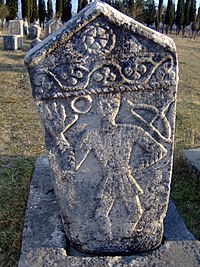Tag:historic=stećak: Difference between revisions
Created page with "{{ValueDescription |key=historic |value=stećak |image=File:Bosniangraves bosniska gravar februari 2007 stecak stecci3.jpg |description=Specifies megalithic gravestone from medieval Bosnia |osmcarto-rendering=File:Stecak icon osm 16.svg |osmcarto-rendering-size=28px |group=historic |onNode=yes |onWay=no |onArea=yes |onRelation=yes |requires= |combination=*{{Tag|name}} *{{Tag|historic|stećak necropolis}} *{{Tag|inscription}} *{{tag|material|limestone}} *{{Tag|heritage}}..." |
(No difference)
|
Revision as of 18:32, 22 October 2023
 |
| Description |
|---|
| Specifies megalithic gravestone from medieval Bosnia |
| Rendering in OSM Carto |
| Group: historic |
| Used on these elements |
| Useful combination |
| Status: in use |
| Tools for this tag |
|
A stećak is a monumental gravestone slab or megalith, cut exclusively in Dinaric Karst limestone in variety of sizes and shapes which, however, followed ordered pattern, erected as a monument (tombstone) on top of the grave and mostly grouped in cemeteries or necropolises, but sometimes as tombstones for individual graves. At present there are more than 60 thousand individual ![]() stećak tombstones in
stećak tombstones in ![]() Bosnia and Herzegovina, and another several thousands in border areas of neighboring countries, mostly in necropolises comprised of few to few hundreds of individual stones. A stećak has been used as early as beginning of the 12th century to as late as mid to late 16th, in some cases early 17th century, for funerals or commemorative purposes.[1][2]
Bosnia and Herzegovina, and another several thousands in border areas of neighboring countries, mostly in necropolises comprised of few to few hundreds of individual stones. A stećak has been used as early as beginning of the 12th century to as late as mid to late 16th, in some cases early 17th century, for funerals or commemorative purposes.[1][2]
Stećaks that will later evolve into transitional variety of stećak-"nišan"s, a variety of stećak used in late medieval Bosnia by first converts to Islam after the Ottoman conquest of the Kingdom of Bosnia, could be mapped as stećak in combination with religious affiliation. Later still, these stećak-nišans will evolve into their final form as Muslim gravestones called nišan(s).[3]
On initiative of the Commission to Preserve National Monuments of Bosnia and Herzegovina, stećaks are inscribed on the World Heritage List on Wikipedia by UNESCO on Wikipedia since 2016. More than 4,000 individual monoliths are selected, and grouped in necropolises at 28 locations, of which 22 in Bosnia and Herzegovina,[4] two in Croatia, three in Montenegro, and three in Serbia.
How to map
For individual stećak, add a node ![]() and add historic=stećak + name=* + inscription=* + heritage=*. If a significant individual stećak(s) is encountered, draw those as an area. This can be done also inside necropolis area
and add historic=stećak + name=* + inscription=* + heritage=*. If a significant individual stećak(s) is encountered, draw those as an area. This can be done also inside necropolis area ![]() . Use combination with historic=stećak necropolis + material=limestone + name=*.
. Use combination with historic=stećak necropolis + material=limestone + name=*.
Examples
-
Radimlja
-
Radimlja
-
Radimlja
-
Radimlja
Tags to use in combination
See also
- See also Stele on Wikipedia



